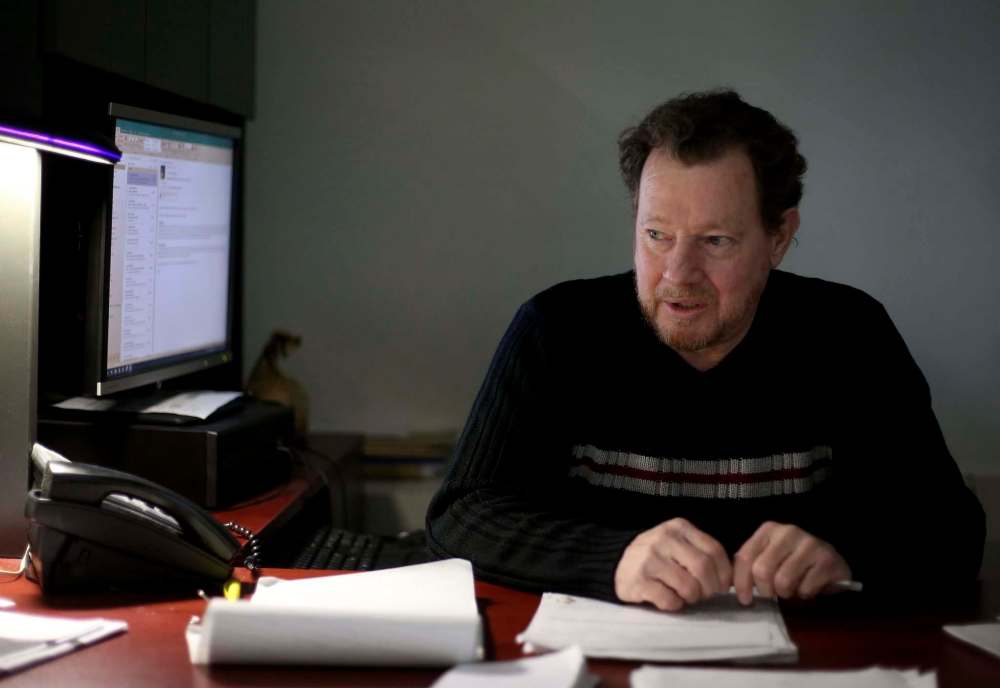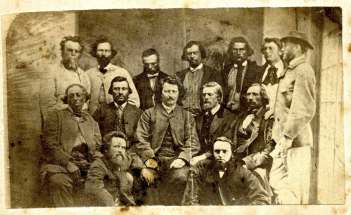APTN journey reaches 20 Mandate to focus on Indigenous lives and cultures includes more original shows, bureaus across Canada
Read this article for free:
or
Already have an account? Log in here »
To continue reading, please subscribe:
Monthly Digital Subscription
$0 for the first 4 weeks*
- Enjoy unlimited reading on winnipegfreepress.com
- Read the E-Edition, our digital replica newspaper
- Access News Break, our award-winning app
- Play interactive puzzles
*No charge for 4 weeks then price increases to the regular rate of $19.00 plus GST every four weeks. Offer available to new and qualified returning subscribers only. Cancel any time.
Monthly Digital Subscription
$4.75/week*
- Enjoy unlimited reading on winnipegfreepress.com
- Read the E-Edition, our digital replica newspaper
- Access News Break, our award-winning app
- Play interactive puzzles
*Billed as $19 plus GST every four weeks. Cancel any time.
To continue reading, please subscribe:
Add Free Press access to your Brandon Sun subscription for only an additional
$1 for the first 4 weeks*
*Your next subscription payment will increase by $1.00 and you will be charged $16.99 plus GST for four weeks. After four weeks, your payment will increase to $23.99 plus GST every four weeks.
Read unlimited articles for free today:
or
Already have an account? Log in here »
Hey there, time traveller!
This article was published 13/12/2019 (2188 days ago), so information in it may no longer be current.
In 1999, a television network launched that would change the landscape of Canadian media forever.
My memories of the early years of the Aboriginal Peoples Television Network are oddly specific: Dances with Wolves played almost constantly, giving me a lifelong obsession with both the American Civil War and actor Kevin Costner, and a show called Tipi Tales aired regularly, marking the first time I remember seeing someone who looked like me on TV… even though all the characters were played by puppets.
Over a decade later, I got to meet those puppets live and in person as a student at the CBC New Indigenous Voice Program. Presented by the National Screen Institute (NSI), the program provides culturally sensitive training in film, television and media for Indigenous creators aged 18-35.

Meeting those puppets really got me thinking about just how far Indigenous representation in the media has come since APTN debuted on Sept. 1, 1999.
● ● ●
The first rumblings of what would eventually become APTN started when Television Northern Canada began working toward a national network. An advisory committee was struck.
“I was involved in the advisory committee that helped set up APTN,” says Jean La Rose, APTN’s CEO. “The goal at that time was to define what the mission and mandate would be.”
That mission eventually became a commitment to sharing the journey of Indigenous peoples by celebrating Indigenous cultures, inspiring children and honouring the wisdom of elders.
“My work over that initial period was to help define the future of what APTN would be, before it was presented to the Canadian Radio-television and Telecommunications Commission,” La Rose says.
With a licence granted, APTN officially launched in 1999, but it soon began facing challenges. In 2002, La Rose took over as CEO.
“When the network launched, it had made commitments for which there were no resources to cover them,” he says, “so the first year was really about getting our finances back in shape and getting us in a better position with the individuals the network had made commitments to.”
“Once we got that in order, my job was to slowly build the network into what it is today.”
Twenty years later, APTN broadcasts news, entertainment and educational programming to nearly 11 million households across Canada, and with a continued focus on creating original programming. You would have a hard time finding Dances with Wolves airing on the network these days.

One of the network’s first original programs, Cashing In, debuted in 2009, and more APTN-created shows have reached the airwaves since. Programs such as First Contact, Mohawk Girls, and That’s AWSM have continued to grow the network.
As of 2019, APTN has committed to 46 television productions and 18 original digital media components, representing more than 389 hours of original programming in languages including English, French, Inuktitut, Cree and more.
All of that happened in the 17 years under the guidance of La Rose, who is retiring on Monday.
La Rose’s office is mostly empty now, although a few remnants remain: a rendition of Ossie Michelin’s photo of a woman kneeling and holding a feather in front of a group of RCMP officers at an anti-fracking protest in Elispogog, N.B. hangs on the wall, while a gifted hand drum sits in a bag decorated with ribbon on the floor.
There is also, curiously, a Santa suit draped over several chairs.
“I think it’s for the Christmas drive,” says Danielle Perrault, executive co-ordinator to the CEO, who will soon be Monika Ille, who has worked at APTN for 16 years.
‘When the network started, it was so small,” says Ille. “Now we’ve expanded into production and distribution, we’ve launched two radio stations in Ottawa and Toronto, and we just launched APTN LUMI, our over-the-top streaming service. We’re trying to ensure APTN keeps a place in the industry.”
“We have a solid foundation,” says Ille. “My goal is to build upon that.”
The building APTN calls home occupies 19,000 square feet on Portage Avenue in downtown Winnipeg. Outside, there is an Indigenous garden, created in partnership with Downtown Winnipeg BIZ.
“We’re really proud to have APTN in downtown Winnipeg,” says Kate Fenske, Downtown Winnipeg BIZ’s CEO. “We want downtown Winnipeg to be an inclusive community where everybody feels welcome and APTN plays a big role in that.”

Inside, APTN’s halls are scattered with Indigenous artwork and maps of traditional territories. The offices have big windows that overlook Winnipeg’s core. The boardroom features a round table — reminiscent of a medicine wheel — made from one single tree.
“It’s considered a symbol of peaceful interaction among all living things,” says communications co-ordinator Emelia Fournier.
In HR, the holiday decorations are out and the walls are covered with framed photos of dogs.
“We’d like to bring our dogs in here,” says HR generalist Donna Miller, “but this is the next best thing.”
Miller has worked at APTN for 20 years, having started one month after the company’s inception.
“I started in reception, then went to accounting, facilities and finally HR,” she says. “There’s a lot of room for advancement and growth here.”
Investigative unit
The APTN newsroom has an in-house studio where it films, and a balcony that is home to the network’s investigative unit, run by Paul Barnsley.
“We’re in the middle of Season 11 right now,” says Barnsley, of the unit. “I’ve been here the whole time… a little before that, actually. It took us some time to set up.”
The unit debuted with Adopt an Indian, an investigation of a government policy that saw Indigenous children adopted out in to non-Indigenous homes.
I ask him what it takes to be an investigative journalist.

“You gotta be smart. Nosy. Curious. You gotta understand how things work,” he says. “It’s basically solving puzzles. Not everyone has every skill you need, so we work in a collaborative way.”
Whether it’s a single department or as a whole, APTN is no stranger to collaboration. It partners with numerous organizations, including the National Screen Institute, where several APTN employees, including Jean La Rose, serve on NSI’s board of directors.
It’s also where I began my writing career and met those inspirational celebrity puppets of my childhood.
“APTN has been a sponsor of the New Indigenous Voices program since the beginning,” says Ursula Lawson, NSI’s manager of programs and development. “They’ve been very supportive and have made a large investment in developing Indigenous talent. There’s a new confidence in our students now, because they know there are opportunities out there.”
Through that partnership, Lawson notes APTN’s investment in Indigenous creators enables Indigenous stories to be told directly by Indigenous people rather than appropriated by non-Indigenous people.
“Historically, Canadian media has done a poor job reflecting the realities of Indigenous people in Canada, and as such, has failed to inform and educate non-Indigenous people on the real history and issues of this country,” says CBC journalist Waubgeshig Rice. “But over the past two decades, APTN has grown to flourish as an essential source of news, information, and current affairs regarding Indigenous peoples throughout this land.
“Canadian media is richer with its presence.”
While the network’s mandate is to Indigenous viewers and stories, it is recognized as one of the most important television networks in North America.
“APTN is more than just news and entertainment,” says Jason Hannan, associate professor in the University of Winnipeg’s department of rhetoric, writing and communications. “It’s a medium of empowerment for the maintenance and creative development of culture and tradition.
“It features innovative content that’s highly original, expertly produced, and extremely engaging for diverse audiences,” he continues. “I always encourage my students, regardless of their background, to watch it.”

APTN’s future looks pretty bright.
“I am very confident that APTN is going to remain in very good hands,” says La Rose. “There will be many more surprised to the things we can achieve in the future.
“When we launched, there were between six to eight Indigenous producers. Now there’s over 100 which we’re working with. That’s where we’re at today. It finally gave us a voice.”
“I want APTN to be here in another 20 years,” adds Ille. “It’s important that Indigenous people have a place, a safe space… and a voice.”
Frances.Koncan@freepress.mb.ca
Twitter: @franceskoncan

Frances Koncan (she/her) is a writer, theatre director, and failed musician of mixed Anishinaabe and Slovene descent. Originally from Couchiching First Nation, she is now based in Treaty 1 Territory right here in Winnipeg, Manitoba.
Our newsroom depends on a growing audience of readers to power our journalism. If you are not a paid reader, please consider becoming a subscriber.
Our newsroom depends on its audience of readers to power our journalism. Thank you for your support.












